Korean merchants have kept the Slauson swap meet alive for 40 years. Their final chapter is near

- Share via
Moon-ho Kim lounged on a bed in his acupuncture stall with his arms folded behind his head, watching the Korean news on TV.
He had worked for years as a construction worker, then an electrician to scrape together the money to open the five-bed stall.
But in two hours on this Wednesday afternoon, no customers had arrived. He and other vendors at Slauson Super Mall in South L.A. were keeping a mostly fruitless vigil.
Like Kim, many are Korean immigrants who spend seven days a week peddling their wares to a mostly Black clientele.
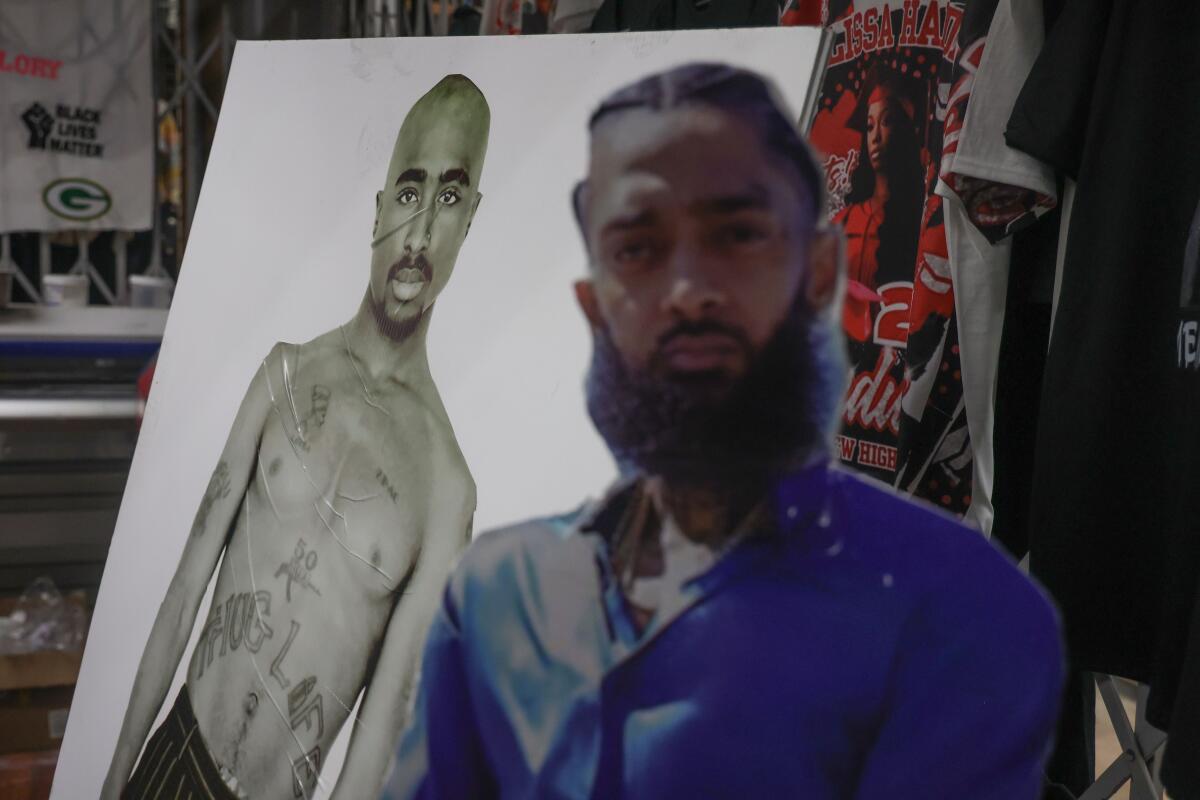
“I get by,” said Kim, 60, who is of Korean descent and grew up in China. “I eat and live day by day.”
Name-checked by Nipsey Hussle and other rappers — “This is how we ball ... Slauson Mall” — the hulking green warehouse-like building is a place to get a suit and tie, 7-inch platform shoes, wigs, bejeweled tooth decorations or a custom R.I.P. shirt to commemorate a deceased loved one. It’s often called a swap meet, but the stalls are like small stores, with permanent walls and shelves, where a customer can not only dress and accessorize head to toe but also get a manicure and a tattoo, haggling over prices to get a good deal. The food court sells fried Cajun-style chicken, pupusas and Korean tofu stew.
The Korean merchants weathered a boycott in 1990 over allegations that they were rude to Black customers, staved off looters during the 1992 riots and survived the COVID-19 pandemic by setting up in the parking lot.
Now, many are approaching retirement, with the swap meet in decline as customers migrate to the internet. The long hours at their stalls paid for their children’s college educations — by design, the next generation won’t be taking over. New vendors, including some Latinos who were employees and then started businesses of their own, are trying their luck.
At Timothy Jeong’s clothing stall — one of the largest and busiest at Slauson Super Mall — a customer called out her pant size. “38, 32! 38, 32!”
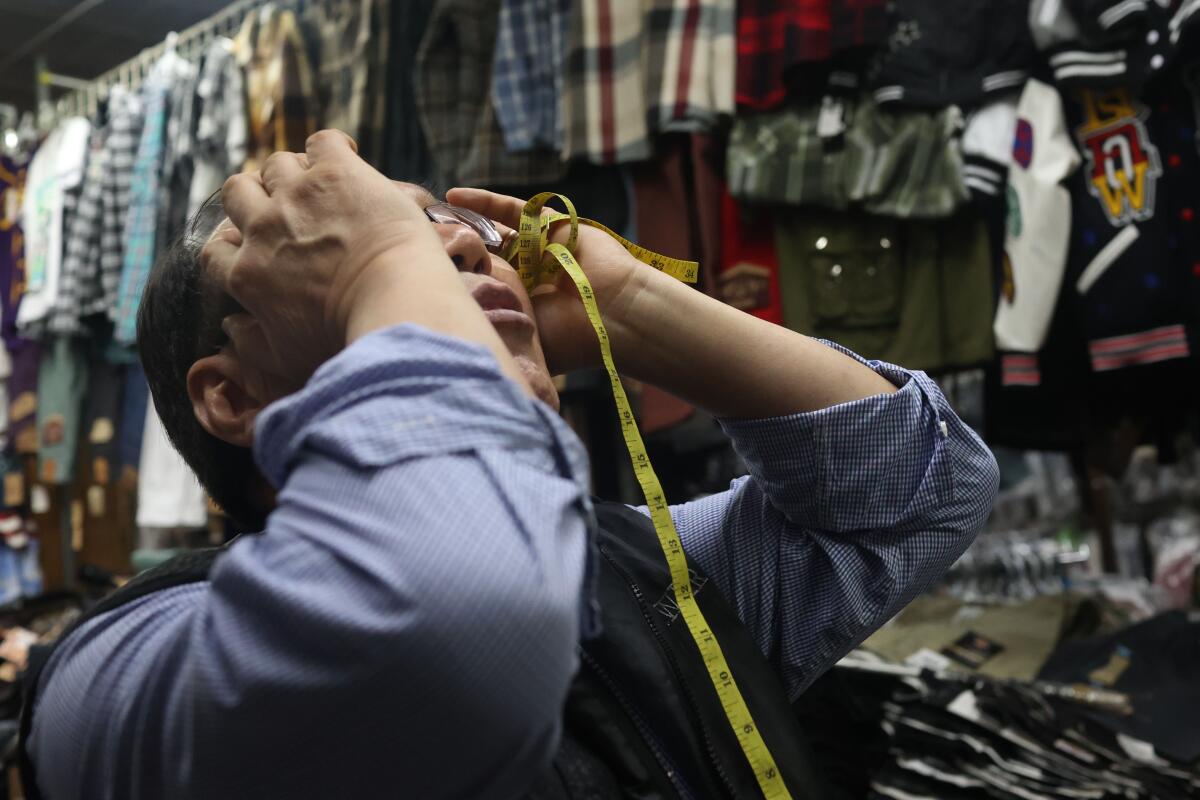
A measuring tape dangling around his neck, Jeong impatiently sifted through mounds of clothing that seemed as disorderly as a hoarder’s home. He says there’s a method to the madness.
He cursed under his breath in Korean.
The customer, Deannette Martin, has been coming to Slauson Super Mall for over a decade and frequents Jeong’s shop for its collection of cargo pants. As a security guard at the DMV in Culver City, she needs the large pockets for her radio and keys.
She tried on a size 36, but it was too small — she needed a 38.
“My helper, I gave to her,” Jeong said over his shoulder as he continued to rummage.
“Papa! Papa!” Martin, 56, who lives in Crenshaw, yelled from the front of the store. “Come over here. Look, you probably put it back here.”
Jeong finally gave up and asked Martin, who had prepaid for the pants, to come back the next day.
About 40 minutes later, Vernon Nash entered the stall, ducking under the clothes hanging from the ceiling like a welcome curtain.
“This one, handmade. Not sewing machine,” Jeong said, holding up a black suit jacket. “$359. My price, $149.”
“Can you do a little better than half price?” asked Nash, 65, a longtime customer who lives in South L.A.
Jeong kept on with his sales patter until he clinched the deal.
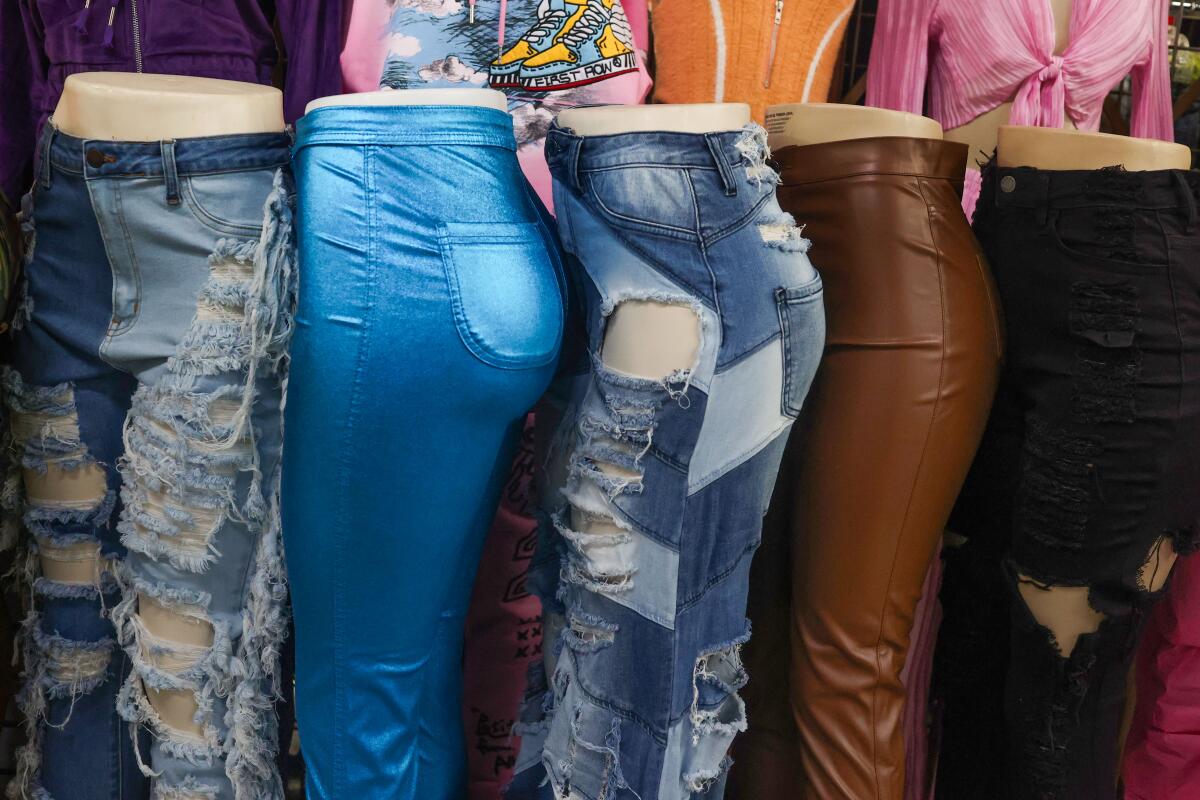

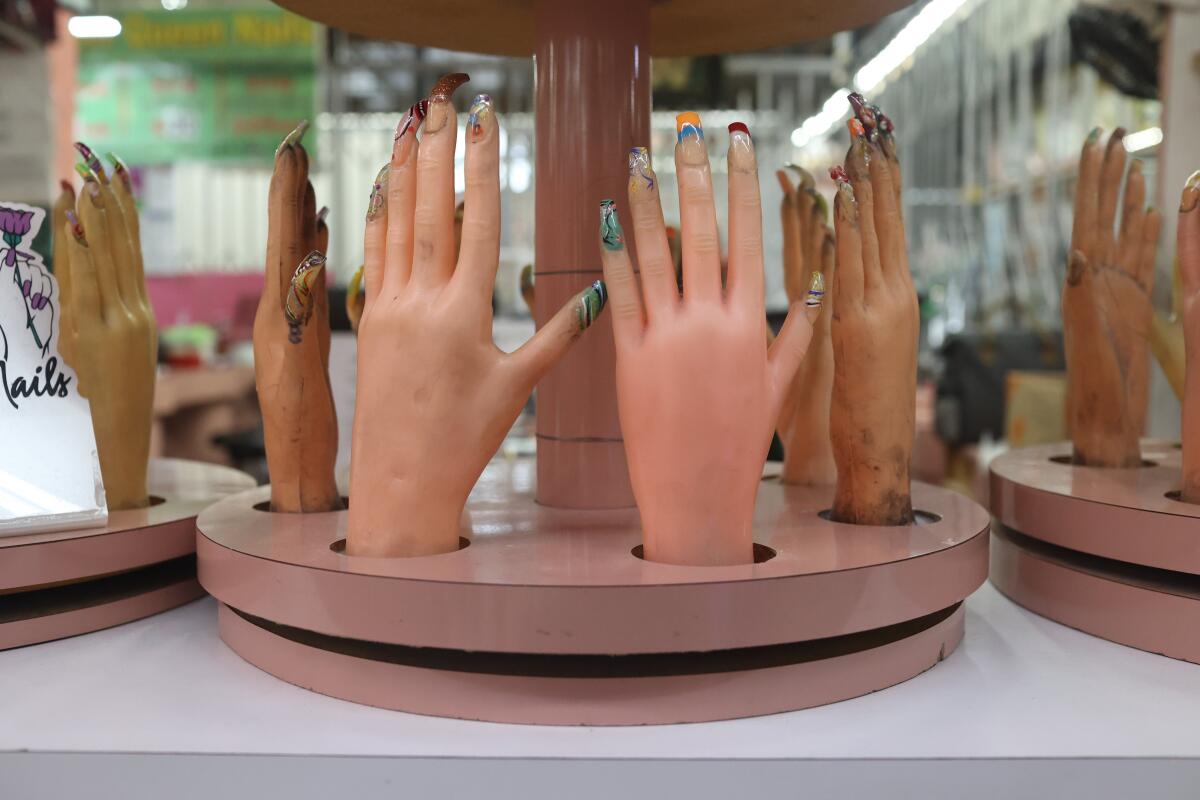
1. Tight jeans are displayed for customers. 2. Colorful hills and platform stripper shoes are displayed for customers. 3. Acrylic nail designs are displayed for customers at Queens Nail. (Michael Blackshire/Los Angeles Times)
In South Korea, Jeong imported livestock for Korean Airlines. After he arrived in the U.S. in 1983, his path was shaped by his connections with other immigrants. He got into the swap meet business through a friend.
“Your life is determined by who picks you up at the airport, who you know,” said Jeong, 75.
In 1988, he opened a 200-square-foot clothing stall at Slauson Super Mall, gradually expanding to 4,000 square feet. The scale allows him to turn a profit, he said — if only a tenth of what he made during the swap meet’s heyday — despite the challenges of selling retail clothing in an internet economy.
Jeong has barely taken a vacation in 37 years, working nine hours a day, seven days a week. He has two sons, one a pharmacist and the other a bioengineer. They won’t be taking over the stall when he retires in a few years.
“To make everything successful, you must sacrifice,” he said. “I give [my family] money to travel, but I don’t go. I’m proud to support them.”
Slauson Super Mall opened in 1985, with Korean immigrants selling clothing, snacks, ice cream and groceries.
In 1992, as people looted and torched businesses in South L.A. after the acquittal of the police officers who beat Rodney King, Christine Na decided to flee the swap meet. As she pulled out of the parking lot, looters came flooding in, banging on her car.
More than a dozen Black security guards stood their ground, protecting the Korean-owned stalls for several days, according to Na and other stall owners. The swap meet remained closed for 18 days.
“It was mentally such a traumatic time, but we were so lucky because of the security guards,” said Na, who opened her first stalls in 1988 and still operates a shoe stall.
In a part of the city beset by violence and gangs, robberies and fights spilled into the swap meet in the 1990s and early 2000s, when the homicide rate was several times higher than today.
These days, vendors pay $300 to $500 a month for security, on top of about $4,000 for a 400-square-foot stall. About a dozen armed security guards roam the aisles. When entering the swap meet, customers pass through a metal detector and have their bags inspected.
Some merchants blame the strict security for driving customers away, while others welcome the safer environment.
The manager of Slauson Super Mall denied requests for comment.
Anita McCoy, one of the few Black vendors at the swap meet, employs local residents at her makeup and clothing stalls — including a man who was released from prison in 2020 and wore an ankle monitor for the next two years.
“They’re in a lifestyle that they chose or grew up in,” said McCoy, 43. “They never learned how to work a [cash register] machine. And who’s going to trust a felon with all that money? But I did.”
McCoy, of Long Beach, sometimes transforms her clothing stall into a soup kitchen, making meals on an electric skillet for homeless people.
It’s tough for other Black entrepreneurs to establish a foothold at the swap meet, she said. The rent goes up almost every year, and she pays about $13,000 a month for four stalls.
But slowly, the demographics are changing. The Korean stall owners have long employed Latino workers, and some have become bosses themselves.
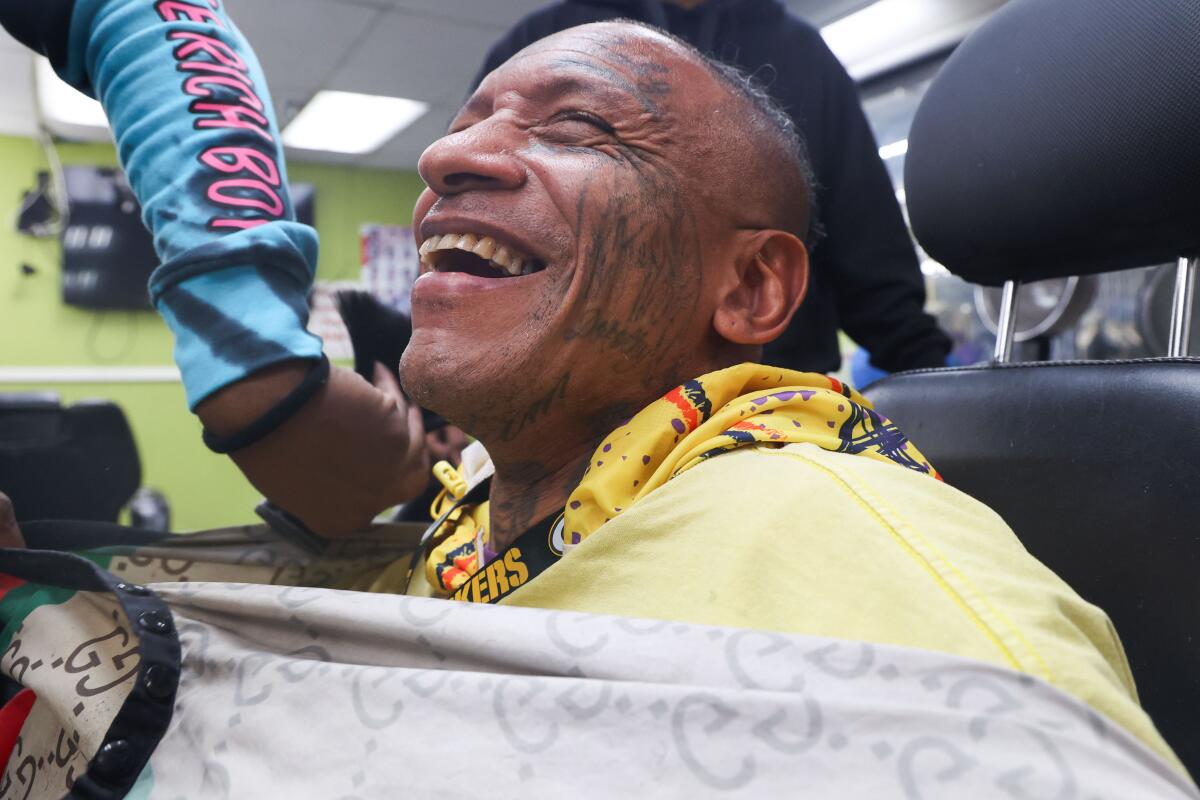
Alma Moreno began working at Jeong’s clothing stall in 1997 as an undocumented immigrant raising several children.
By 2015, she had her papers and had saved enough to open her own stall selling baby clothes. She now owns three stalls, with her daughter helping at one of them.
On this Wednesday, Irma Gomez, who works at Jeong’s stall, stopped by to chat in Spanish with Moreno.
“You’re next,” Moreno, 45, said to Gomez with a determined look. “We’re going to get you a stall of your own next.”
At Mr. Bling Grillz, Tony McCoy was picking up a 14-karat gold grill.
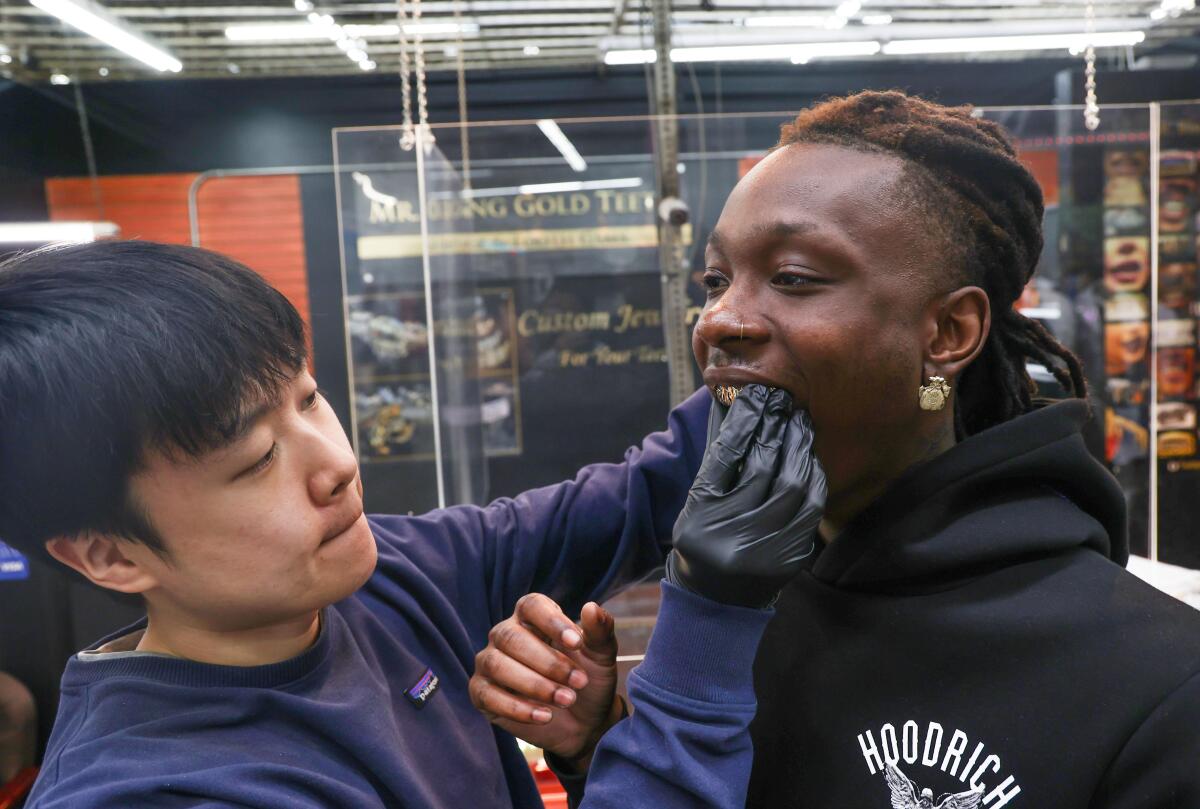
Around him, teeth coverings sparkled on the shelves — diamond, gold, opal, some featuring designs including a pink fang-shaped outline.
“I always wanted one, and sporting grills is just a part of the urban culture here,” said McCoy, 29, who grew up next to the swap meet and works at an AT&T call center.
McCoy’s grill, his first, cost $600. The addition of a single precious stone could have upped the price to $1,600, said Jae Choi, nephew of the owner, a Korean immigrant who goes by Mr. Bling.
Celebrity clients include Lizzo and Tyler, the Creator. Lil Nas X spent around $10,000 at Mr. Bling for the custom grill he wore in a Doritos Super Bowl 2020 commercial, according to Choi.
Choi, 33, has been running the business since last summer after his uncle returned to South Korea for health reasons. He is the only second-generation Korean he knows of who has taken over a business at the swap meet from an older relative.
“I dropped out of college, because I saw room to grow the business,” Choi said. “I think a different wave of trend is coming, and I’m more suited for that younger taste and culture.”
For some South L.A. natives, the swap meet is a family tradition.
At Queen Nails, Cereniti Martinez admired her fresh French tips as she waited for her mother, Devon Martinez, to finish a manicure.
Growing up in South L.A., Devon Martinez got her nails done with her own mother at the swap meet every couple of weeks. Now, she does the same with her daughter, even though they live in the Wilshire district.
Cereniti, 14, often refreshes her wardrobe at the swap meet, noting the “really great price range.”

For some of the longtime Korean merchants, the swap meet’s decline is a depressing end to their careers, even as their toil there has earned them a modest version of the American dream.
Na, the shoe stall owner who fled the rioters, recalls the swap meet’s peak in the 1990s and early 2000s, when people parked at the church next door because the parking lot was always full.
“Now, you could play bowling down this corridor,” she said. “There’s not a single person in sight.”
She started with three stalls, selling men’s clothing as well as shoes, paying off her mortgage and putting her kids through college.
Now, she works alone in the one shoe stall she still operates — nine hours a day, seven days a week, sitting on a cushioned foot stool and watching people walk by without stopping to browse for shoes.
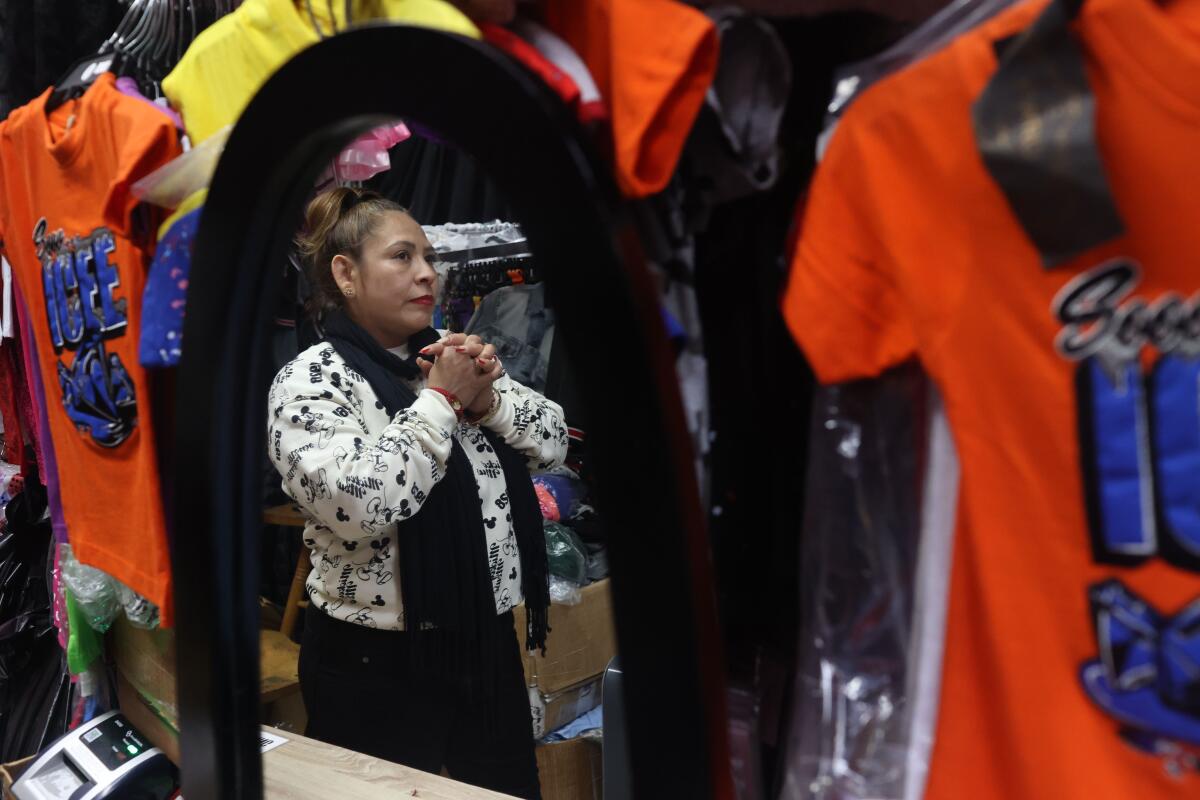
“If I thought I would have to struggle this much just to make a living, I probably would have just stayed in Korea,” she said. “Will [the Korean vendors] even make it to 10 years? Five years? With the way business is going?”
More to Read
Sign up for Essential California
The most important California stories and recommendations in your inbox every morning.
You may occasionally receive promotional content from the Los Angeles Times.











